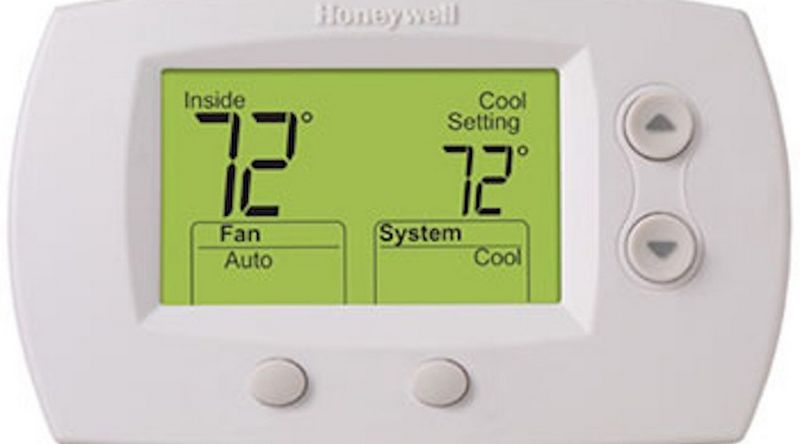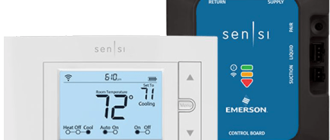
How Smart Thermostats Work and Can Save You Money
In today’s modern age, technology is constantly evolving to make our lives easier and more efficient. One such innovation is the development of programmable thermostats, which have now evolved into smart thermostats. These devices not only help us control the temperature in our homes but also help us save money in the process.
Smart thermostats, as the name suggests, are intelligent devices that can be programmed to adjust the temperature in your home based on your preferences and schedule. They use sophisticated algorithms and sensors to learn your heating and cooling patterns and optimize energy consumption. By using a smart thermostat, you can set different temperatures for different times of the day, ensuring that your home is always at the desired temperature when you need it.
One of the main advantages of smart thermostats is their ability to save you money. By optimizing the temperature in your home, these devices reduce energy waste, resulting in lower utility bills. They can intelligently adjust the temperature when you’re away from home or asleep, ensuring that energy is not wasted on heating or cooling an empty space. Additionally, smart thermostats provide reports and insights on your energy usage, allowing you to identify areas where you can further improve efficiency and save even more money.
Another benefit of smart thermostats is their ability to connect with other smart devices and platforms, such as smartphones and home automation systems. This allows you to control the temperature of your home remotely, even when you’re not on the premises. You can adjust the thermostat settings while you’re at work or on vacation, ensuring that your home is always comfortable when you return. This level of convenience and control further enhances the energy-saving capabilities of smart thermostats.
In conclusion, smart thermostats are a revolutionary technology that combines convenience, efficiency, and savings. By programming and optimizing the temperature in your home, these devices help you save energy and money. With their ability to connect with other smart devices, smart thermostats give you complete control over your home’s temperature, no matter where you are. Investing in a smart thermostat is a wise decision that will not only benefit your wallet but the environment as well.
What is a Smart Thermostat?
A smart thermostat is a device that helps save money and energy by automatically adjusting the temperature in your home based on your preferences and behavior. Unlike traditional thermostats, which require manual adjustments, smart thermostats are programmable and can learn your schedule and habits to optimize energy efficiency.
Smart thermostats work by connecting to your home’s Wi-Fi network and integrating with other smart devices, such as your phone or voice assistants like Amazon Alexa or Google Assistant. This connectivity allows you to control your thermostat remotely through a smartphone app or voice commands, giving you the ability to adjust the temperature even when you’re not at home.
By using sensors and advanced algorithms, smart thermostats can automatically adjust the temperature based on factors such as the time of day, occupancy, and weather conditions. For example, the thermostat can lower the temperature when you’re away from home and raise it before you return, ensuring comfort and saving energy.
One of the key benefits of smart thermostats is their ability to learn your preferences over time. They can analyze your behavior, such as when you wake up, when you leave for work, and when you go to bed, and adjust the temperature accordingly. This personalized approach helps optimize energy efficiency and saves you money on heating and cooling costs.
In addition, some smart thermostats also provide energy usage reports and recommendations, showing you how much energy you’re consuming and suggesting ways to improve efficiency. This information can help you make informed decisions about your energy usage and identify areas where you can further save money.
Overall, smart thermostats offer convenience, energy savings, and increased efficiency. They provide a modern and intuitive way to control and manage the temperature in your home. Whether you’re looking to reduce your carbon footprint or save on utility bills, a smart thermostat can be a valuable addition to your household.
Benefits of Using a Smart Thermostat
Smart thermostats offer several benefits compared to traditional thermostats, including increased energy efficiency and money savings. These programmable devices can be easily controlled and adjusted to optimize temperature settings, resulting in reduced energy consumption and lower utility bills.
One of the key advantages of smart thermostats is their ability to automatically adjust the temperature based on your preferences and daily routines. They learn from your behavior, adapting to your schedule and making sure the temperature is comfortable when you’re home, and conserving energy when you’re away.
By optimizing your home’s heating and cooling system, smart thermostats help reduce energy waste and lower your carbon footprint. They also provide insights and data on your energy usage, helping you to identify areas where you can further save energy and money.
Another advantage of smart thermostats is their compatibility with other smart devices, such as voice assistants or smartphone apps. This allows for convenient control and monitoring of the temperature from anywhere, whether you’re in bed or on vacation.
In addition to energy savings, smart thermostats offer increased comfort and convenience. You can set different temperature zones in your home, ensuring that each room is heated or cooled to your liking. Some models even have features like geofencing, which can automatically adjust the temperature when you leave or return home.
In summary, smart thermostats provide numerous benefits, including energy efficiency, money savings, increased comfort, and convenience. By optimizing temperature settings and reducing wasteful energy consumption, these devices contribute to a greener and more sustainable future.
Energy Saving Features
Smart thermostats are designed with energy-saving features that can help homeowners reduce their energy consumption and save money on their utility bills.
One of the main energy-saving features of smart thermostats is their programmable capabilities. With a programmable thermostat, homeowners can schedule temperature changes throughout the day based on their needs and preferences. This allows them to turn down the heating or cooling when they are not home or during times when they are typically asleep, reducing energy consumption and saving money. Programmable thermostats also make it easy to set different temperature zones for different areas of the house, optimizing energy efficiency.
In addition to programmability, smart thermostats use advanced technology to learn homeowners’ behaviors and adjust temperature settings accordingly. They can analyze data such as occupancy patterns, weather conditions, and historical temperature preferences to automatically optimize temperature settings for energy efficiency. For example, if the thermostat detects that everyone has left the house, it can automatically adjust the temperature to an energy-saving level. These intelligent features help homeowners save energy without needing to constantly adjust the thermostat manually.
Smart thermostats also offer energy-saving insights and recommendations. They provide homeowners with detailed information about their energy usage, allowing them to identify patterns and make informed decisions to reduce energy consumption. Some smart thermostats can even provide real-time energy usage data and send alerts when energy usage is higher than usual, helping homeowners identify areas where they can make adjustments to save energy and money.
Overall, smart thermostats are designed with energy-saving features that make them a valuable tool for homeowners looking to reduce their energy consumption and save money. Their programmable capabilities, advanced technology, and energy-saving insights provide a convenient and efficient way to optimize energy usage and increase energy efficiency in the home.
Remote Access and Control
One of the key features of smart thermostats is the ability to remotely access and control your home’s heating and cooling system. With traditional programmable thermostats, you had to physically be in front of the thermostat to adjust the temperature settings. However, with smart thermostats, you can easily control your home’s temperature from anywhere using your smartphone or computer.
This remote access and control feature offers numerous benefits for homeowners. Firstly, it allows you to work with your thermostat even when you are not at home. For example, if you are on vacation and realize you forgot to adjust the temperature before leaving, you can easily access your smart thermostat through an app and make the necessary changes. This saves you from wasting energy and money by heating or cooling an empty home.
In addition to saving money, remote access and control also helps improve energy efficiency. By adjusting the temperature settings based on your schedule and occupancy patterns, you can optimize energy usage and reduce unnecessary heating or cooling. For example, if you typically leave for work at 8 am, your smart thermostat can automatically adjust the temperature to save energy while you’re away and then bring it back to a comfortable level before you return home.
Furthermore, remote access and control allows you to monitor and manage your energy usage. Smart thermostats often come with detailed energy usage reports that show you how much energy you are consuming and when. This information can help you make informed decisions about your energy usage habits, identify areas where you can save energy, and ultimately help you lower your energy bills.
| Conveniently adjust temperature settings from anywhere |
| Prevent energy waste by adjusting settings when away |
| Improve energy efficiency by optimizing temperature based on schedule |
| Monitor energy usage and make informed decisions |
Compatibility with Other Smart Devices
Smart thermostats are designed to work seamlessly with other smart devices in your home. This compatibility ensures that your thermostat works in conjunction with other devices to create a connected and efficient home environment.
One of the main benefits of smart thermostats is their ability to work with other smart devices to optimize temperature and energy efficiency. For example, a smart thermostat can communicate with your smart lighting system to automatically adjust the temperature when you leave the house or enter a specific room. This integration allows your home to maintain a comfortable temperature while saving energy.
In addition to smart lighting, smart thermostats can also work with other devices such as smart speakers, smart locks, and smart appliances. This integration allows you to control your thermostat using voice commands or through a mobile app, making it even more convenient and easy to use.
By connecting your smart thermostat to other devices, you can create custom schedules and settings to further enhance energy efficiency. For instance, you can program your thermostat to lower the temperature during the night when everyone is sleeping, and raise it in the morning before everyone wakes up. This level of customization helps you save money on energy bills while ensuring a comfortable living environment.
When choosing a smart thermostat, it is important to consider its compatibility with other smart devices in your home. Make sure that the thermostat you choose works with popular smart home platforms like Amazon Alexa, Google Assistant, or Apple HomeKit. This compatibility ensures that you can easily integrate your thermostat with your existing smart home ecosystem.
In conclusion, the compatibility of smart thermostats with other smart devices is essential for their effective operation and energy-saving capabilities. By integrating your thermostat with other devices, you can create a connected and efficient home environment that maximizes energy efficiency and saves you money in the long run.
Learning and Adaptive Technology
Smart thermostats are equipped with learning and adaptive technology, which allows them to analyze and understand your energy consumption patterns and optimize the heating or cooling of your home for maximum efficiency. By learning about your lifestyle and occupancy habits, smart thermostats can create a personalized schedule that matches your needs and preferences, ultimately saving you money on your energy bills.
These thermostats can learn how long it takes to heat or cool your home to a specific temperature and adjust accordingly. For example, if you always come home at 6 p.m., the thermostat can start heating or cooling your home a few minutes before that time, so it’s at the desired temperature when you arrive. Similarly, if you have a regular routine of leaving the house in the morning, the thermostat can lower the temperature while you’re away to save energy.
In addition to learning your schedule and habits, smart thermostats can also adapt to changes in temperature preferences. For instance, if you manually adjust the temperature multiple times, the thermostat will start to understand your preferences and make automatic adjustments in the future. This adaptive technology ensures that your home is always at a comfortable temperature without wasting unnecessary energy.
Overall, learning and adaptive technology in smart thermostats provide an intelligent approach to heating and cooling your home. By effectively managing the temperature based on occupancy and individual preferences, these thermostats can significantly improve energy efficiency and help you save money in the long run.
Geofencing Technology
Geofencing technology is a key feature of smart thermostats that helps improve their efficiency and energy-saving capabilities. With geofencing, thermostats can sense when you are leaving or entering your home and adjust the temperature accordingly. This technology uses your smartphone’s GPS or WiFi signal to determine your location and activate predefined temperature settings.
By utilizing geofencing technology, smart thermostats can ensure that energy is not wasted on heating or cooling an empty home. When you leave your house, the thermostat can automatically set the temperature to an energy-saving level, ultimately helping you save money on your utility bills. Conversely, when you start returning home, your smart thermostat can adjust the temperature to a comfortable level before you even enter the house.
Geofencing technology allows for personalized temperature settings based on your daily routine. You can customize your smart thermostat to warm up your home in the morning before you wake up or cool it down when you typically leave for work. This flexibility ensures that you always come back to a comfortable environment without wasting unnecessary energy when you’re not home.
Smart thermostats with geofencing technology can also provide valuable insights into your energy usage. You can track your energy consumption and analyze how adjusting temperature settings affects your bills. By understanding your energy usage patterns, you can make informed decisions to further optimize your home’s energy efficiency and save even more money.
In conclusion, geofencing technology is a powerful tool that enhances the functionality of smart thermostats. By automatically adjusting temperature settings based on your location, geofencing helps save money and improve energy efficiency, making it a valuable feature for any homeowner.
Integration with Smart Home Systems
Smart thermostats are not only programmable to save you money, but they can also work seamlessly with your smart home system to provide maximum convenience and efficiency. By integrating your smart thermostat with other smart devices in your home, such as smart lighting systems or smart speakers, you can control and automate your home’s temperature settings with ease.
With a smart thermostat integrated into your smart home system, you can easily adjust the temperature of your home using voice commands. For example, you can simply say “Hey Google, set the temperature to 72 degrees” to your smart speaker, and it will communicate with your smart thermostat to make the necessary adjustments.
Integration with smart home systems also allows for advanced automation features. You can create custom schedules based on your daily routine or set up location-based triggers that adjust the temperature when you leave or arrive home. This level of automation ensures that your home is always at the ideal temperature, while also saving energy and reducing your utility bills.

In addition, smart thermostats can provide valuable data to your smart home system, allowing for even more efficient temperature control. For example, if your home has a smart lighting system, it can use data from the thermostat to adjust the lighting levels based on the current temperature. This can help to further optimize energy efficiency and create a more comfortable living environment.
| 1. Convenient control through voice commands |
| 2. Customizable schedules and automation |
| 3. Energy-saving optimizations |
| 4. Integration with other smart devices for enhanced comfort |
Overall, integrating your smart thermostat with your smart home system offers a range of benefits, from convenience and energy savings to enhanced comfort and automation. It’s a smart choice for anyone looking to make their home more efficient and comfortable.
Energy Consumption Monitoring
One of the main benefits of programmable and smart thermostats is their ability to monitor energy consumption. These devices are designed to track how much energy is being used to heat or cool a home, allowing homeowners to better understand their energy usage and make adjustments to improve efficiency.
Smart thermostats, in particular, have advanced energy monitoring features that provide detailed information on energy usage. They can show real-time data on how much energy is being consumed, as well as historical data that allows homeowners to see patterns and trends in their energy usage over time. This information can be accessed through the thermostat itself or through a companion app on a smartphone or tablet.
By monitoring energy consumption, homeowners can identify areas where energy is being wasted and make changes to save money. For example, they may notice that energy usage spikes when they set the thermostat to a high temperature, even when no one is home. By adjusting the temperature settings or using features like geofencing to automatically adjust the temperature when the house is empty, they can reduce energy consumption and save on their utility bills.
In addition, energy consumption monitoring can help homeowners track the impact of other energy-saving measures they may be implementing, such as upgrading insulation or installing energy-efficient windows. By comparing energy usage before and after these upgrades, homeowners can quantify the energy savings and determine if further improvements are needed.
Overall, energy consumption monitoring is a powerful tool that allows homeowners to better understand and manage their energy usage. By using programmable or smart thermostats with this feature, homeowners can take control of their energy consumption, improve efficiency, and save money in the long run.
Weather-based Adjustments
Smart thermostats are designed to optimize energy efficiency and save money by adjusting the temperature in your home based on the weather conditions.
By connecting to local weather forecasts and sensors, smart thermostats can automatically adjust the temperature to ensure your home remains comfortable while minimizing energy usage.
For example, on a hot summer day, a smart thermostat can detect that the outside temperature is rising and adjust your cooling system accordingly. This prevents your home from becoming too hot and saves energy by not overcooling unnecessarily.
Similarly, on a cold winter day, the smart thermostat can detect a drop in temperature and adjust your heating system accordingly. This ensures your home remains warm and cozy, while still saving money by not overheating.
Some smart thermostats also take into account factors such as humidity levels and sunlight exposure to further optimize temperature settings. By considering these variables, the thermostat can adjust the temperature more precisely, leading to even greater energy savings.
Overall, weather-based adjustments enable smart thermostats to work more efficiently, resulting in energy savings and lower utility bills for homeowners.
Cost Savings Comparison
Smart thermostats work by learning your temperature preferences and automatically adjusting the temperature in your home to maximize energy savings. Compared to traditional programmable thermostats that can only be programmed to turn on and off at specific times, smart thermostats offer more flexibility and control.
One of the biggest advantages of smart thermostats is their ability to save you money on your energy bills. By adjusting the temperature based on when you’re at home and when you’re away, smart thermostats can help reduce energy waste and lower your heating and cooling costs.
According to studies, smart thermostats can save homeowners an average of 10-15% on their heating and cooling bills. This can amount to significant savings over time. For example, if your monthly energy bill is $200, a smart thermostat could save you $20-$30 per month, or $240-$360 per year.
In addition to the direct cost savings on your energy bills, smart thermostats can also help you save money by taking advantage of energy-saving rebate programs and incentives offered by utility companies. Some utility companies offer rebates or discounts for installing a smart thermostat, which can further reduce the cost of purchasing and installing the device.
Overall, smart thermostats offer both short-term and long-term cost savings. By optimizing your home’s temperature based on your preferences and schedule, smart thermostats can help you save money on your energy bills and take advantage of potential rebates or incentives offered by utility companies. Investing in a smart thermostat can be a smart financial decision that pays for itself in energy savings over time.
Installation and Setup
Installing a smart thermostat is an effective way to save energy and money. These thermostats are designed to be easy to install and set up, even for those with little to no technical expertise.
The first step in installing a smart thermostat is to identify a suitable location for it. This location should be away from any direct sources of heat or cold, such as windows or vents, as well as in an area where it can easily detect the temperature of the room.
Once you have chosen a location, you can begin the installation process. Start by turning off the power to your existing thermostat at the circuit breaker. Remove the old thermostat from the wall and disconnect the wires.
- Gather the supplied mounting plate and attach it to the wall using screws or adhesive.
- Connect the wires from your HVAC system to the corresponding terminals on the smart thermostat.
- Place the smart thermostat onto the mounting plate and secure it in place.
After the physical installation is complete, you will need to set up the smart thermostat using the provided instructions. This typically involves connecting it to your home’s Wi-Fi network and downloading a compatible app on your smartphone or tablet.
Once the smart thermostat is connected and set up, you can begin programming it to optimize energy efficiency and save money. These thermostats often have programmable features that allow you to set schedules for heating and cooling based on your daily routine.
Additionally, smart thermostats can “learn” your preferences over time and adjust the temperature accordingly. This can help save energy by only heating or cooling your home when it’s necessary, rather than maintaining a constant temperature throughout the day.
Overall, the installation and setup of a smart thermostat is a relatively simple process that can provide significant benefits in terms of energy efficiency and cost savings. By taking the time to properly install and program your smart thermostat, you can enjoy a comfortable home while also reducing your energy consumption.
Smart Thermostat Tips and Recommendations
Smart thermostats are an energy-saving solution that can help you save money on your heating and cooling bills. Here are some tips and recommendations for getting the most out of your smart thermostat:
1. Understand how smart thermostats work: Smart thermostats use advanced technology and sensors to monitor and control the temperature in your home. They can learn your habits, adjust the temperature based on your preferences, and even detect when you are away to save energy.
2. Take advantage of programmable features: Most smart thermostats come with programmable settings that allow you to set specific temperature schedules for different times of the day. Take the time to customize these settings to match your lifestyle and save even more energy.
3. Monitor your energy usage: Smart thermostats often come with energy monitoring features that allow you to track your energy usage and identify areas where you can make adjustments to save more money. Pay attention to these insights and make changes accordingly.
4. Utilize remote access: Smart thermostats can be controlled remotely using a smartphone app or web portal. Take advantage of this feature to adjust the temperature when you are away from home or to preheat or precool your house before you arrive.
5. Consider geofencing: Some smart thermostats offer geofencing capability, which uses your smartphone’s location to automatically adjust the temperature based on whether you are home or away. This feature can help optimize energy usage and save you money.
6. Learn from your smart thermostat: Smart thermostats can provide valuable insights and recommendations based on your energy usage patterns. Pay attention to these suggestions and implement them to further optimize your energy savings.
7. Keep your smart thermostat up to date: Regularly check for software updates for your smart thermostat and install them when available. These updates often bring new features and improvements that can enhance your energy-saving capabilities.
In conclusion, smart thermostats are a smart investment that can help you save money on your energy bills. By understanding how they work and implementing these tips and recommendations, you can maximize your energy savings and enjoy a more comfortable home.
Q&A:
How does a smart thermostat work?
A smart thermostat uses advanced sensors and algorithms to monitor and control the temperature of your home. It can learn your preferences and adjust the temperature accordingly, saving energy and money.
What are the benefits of using a smart thermostat?
Using a smart thermostat can help you save money on your energy bills by optimizing your home’s heating and cooling. It can also provide convenience, as you can control the temperature remotely using a smartphone app.
Can a smart thermostat learn my schedule?
Yes, many smart thermostats have the ability to learn your schedule and automatically adjust the temperature based on your preferences. This can help you save energy and ensure comfort when you’re at home.
Do smart thermostats work with voice assistants?
Yes, many smart thermostats are compatible with popular voice assistants like Amazon Alexa and Google Assistant. This allows you to control the temperature simply by using voice commands.
Are smart thermostats easy to install?
Installing a smart thermostat can be relatively easy, especially if you already have a standard thermostat in place. However, if you’re not comfortable with DIY projects, it’s best to have a professional install it for you to ensure proper wiring and functionality.
What is a smart thermostat?
A smart thermostat is a device that can be connected to your home’s heating and cooling system and allows you to control the temperature of your home remotely through a smartphone app or a web interface.






